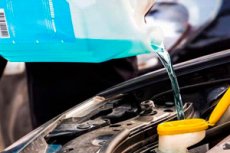Fuel oil vapor poisoning
Last reviewed: 06.10.2024

All iLive content is medically reviewed or fact checked to ensure as much factual accuracy as possible.
We have strict sourcing guidelines and only link to reputable media sites, academic research institutions and, whenever possible, medically peer reviewed studies. Note that the numbers in parentheses ([1], [2], etc.) are clickable links to these studies.
If you feel that any of our content is inaccurate, out-of-date, or otherwise questionable, please select it and press Ctrl + Enter.

Tosol (antifreeze) is a trade name for a non-freezing coolant for the car engine. The substance is water-based and contains liquid alcohols (ethylene glycol, propylene glycol and methanol). The latter are poisonous and dangerous for living organisms.
Causes of the fuel oil poisoning
Tosol poisoning can occur for a variety of reasons. Here are some of the most common:
- Industrial or emergency situations: Workers involved in the production, storage or transportation of fuel oil may be at risk of poisoning in the event of an accident, leak or improper operation of equipment. This can occur in automobile manufacturing plants, steel mills, automotive service stations, and other industrial facilities.
- Misuse in the home: People can sometimes use tosol accidentally or incorrectly, e.g. Instead of water for cooking or to freeze liquids in pipes in the home. This can lead to accidental poisoning.
- Children's play: Children may accidentally swallow tosol if it is available to them in the home or play environment. This can happen if the fuel is out of reach but not securely protected from children.
- Enteringthe digestive system through inadequately processed food: In some cases, tosol can enter the human digestive system through inadequately processed or contaminated food, as it can be used as an antifreeze for cooling systems.
- Targeted criminal use: In rare cases, tosol may be used for criminal purposes to harm others, such as by adding it to drinks or food.
Symptoms of the fuel oil poisoning
Intoxication of the body by vapors of antifreeze is most often unintentional. For example, when transferring the substance from one container to another. Symptoms of poisoning increase gradually over several hours. This is due to the fact that the body metabolizes antifreeze. In the process of absorption, the chemical breaks down into other toxins: glycolic or glyoxylic acid, acetone and formaldehyde.
The main signs of tosol damage include:
- State of Intoxication.
- Headache and dizziness.
- Movement disorder.
- Slurred and slurred speech.
- Increased fatigue.
- Nausea and vomiting.
- Inability to urinate.
- Heart palpitations.
- Seizures.
- Loss of consciousness and development of coma (in particularly severe cases).
The chemical adversely affects the kidneys, lungs, brain and CNS. 24-72 hours after the body is affected by antifreeze, irreversible consequences develop.
Treatment of the fuel oil poisoning
The victim needs emergency medical attention. Before the arrival of the medics, the patient should be taken out into fresh air, rinse the face with water and monitor the respiratory rate. Treatment in a hospital is aimed at removing toxins from the body and maintaining the functioning of all organs and systems.
Here are some steps that can be taken in a medical facility for such poisoning:
- Medical Evaluation and Diagnosis: The victim will undergo a medical evaluation to determine the severity of the poisoning and to assess the condition of the body organs and systems. This may include clinical examination, blood and urine tests, and instrumental diagnostic techniques.
- Neutralizing the fuel oil: The first priority may be to neutralize the fuel oil that has entered the body. This may include gastric lavage or taking activated charcoal to bind and remove toxins.
- Treatment of complications: Tosol poisoning can lead to a variety of complications, including damage to the digestive system, kidneys, and other organs. Treatment of complications may include support of organ function and surgery if necessary.
- Maintenance of vital functions: It is important to ensure that vital body functions such as breathing, circulation, and kidney function are maintained. This may include oxygen therapy, fluid infusion, electrolyte balance and other supportive measures.
- Symptomatic treatment: Treatment is aimed at relieving symptoms of poisoning such as nausea, vomiting, pain and others. This may include the use of antiemetics, analgesics, and other medications as needed.
- Medical observation and rehabilitation: The survivor will be observed in a medical facility to monitor their condition and recovery. This may include medical supervision, rehabilitation therapy and psychological support.

